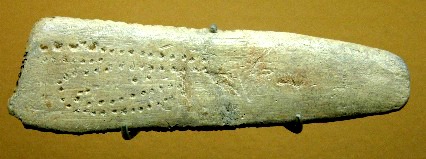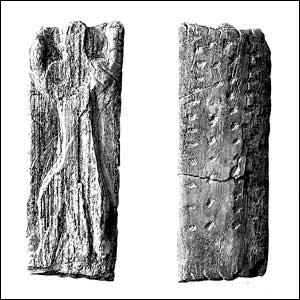Post by 1dave on Jul 28, 2018 14:08:45 GMT -5
Archaeoastronomy: (Prehistoric Astronomers)
For a long time now the scientific establishment has shown a resistance and even disregard to the idea of astronomy having been practiced in prehistory. Thankfully, the question of whether astronomy was practiced is now beyond debate, and the doors are open for us to discover the extent of this important development in human awareness.

The most well-known depiction interpreted by him is found on the bone plate about 30,000 years old, from Abri Blanchard (Dordogne, France) which is said to represent the waxing and waning moon positions in serpentine form.

'The oldest image of a star pattern, that of the famous constellation of Orion, has been recognised on an ivory tablet some 32,500 years old'.
(BBC - Science/nature)
There are 86 notches on the tablet, a number that has two special meanings. First, it is the number of days that must be subtracted from a year to equal the average number of days of a human gestation. This is no coincidence, says Dr Rappenglueck. It is also the number of days that one of Orion’s two prominent stars, Betelguese, is visible. To ancient man, this might have linked human fertility with the gods in the sky.
The Astronomy of the Stonehenge/Avebury Complex.
One of the strongest pieces of evidence in favour of Stonehenge serving an astronomic purpose is the location of the site itself, as it is along this latitude at which the sun and the moon have their maximum declinations at right angles to each other, in addition to which the latitude of Stonehenge (51° 10' N), is one of only two latitudes in the world at which the full moon passes directly overhead on the maximum zenith. The other (38° 33′ N), is perhaps coincidentally on the same as the latitude of the oldest stone-circle in Europe, at Almendres in Portugal.
For a long time now the scientific establishment has shown a resistance and even disregard to the idea of astronomy having been practiced in prehistory. Thankfully, the question of whether astronomy was practiced is now beyond debate, and the doors are open for us to discover the extent of this important development in human awareness.

The most well-known depiction interpreted by him is found on the bone plate about 30,000 years old, from Abri Blanchard (Dordogne, France) which is said to represent the waxing and waning moon positions in serpentine form.

'The oldest image of a star pattern, that of the famous constellation of Orion, has been recognised on an ivory tablet some 32,500 years old'.
(BBC - Science/nature)
There are 86 notches on the tablet, a number that has two special meanings. First, it is the number of days that must be subtracted from a year to equal the average number of days of a human gestation. This is no coincidence, says Dr Rappenglueck. It is also the number of days that one of Orion’s two prominent stars, Betelguese, is visible. To ancient man, this might have linked human fertility with the gods in the sky.
The Astronomy of the Stonehenge/Avebury Complex.
One of the strongest pieces of evidence in favour of Stonehenge serving an astronomic purpose is the location of the site itself, as it is along this latitude at which the sun and the moon have their maximum declinations at right angles to each other, in addition to which the latitude of Stonehenge (51° 10' N), is one of only two latitudes in the world at which the full moon passes directly overhead on the maximum zenith. The other (38° 33′ N), is perhaps coincidentally on the same as the latitude of the oldest stone-circle in Europe, at Almendres in Portugal.











